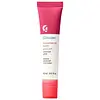Glossier Balm Dotcom Versus Vaseline Lip Therapy
What's inside
What's inside
 Key Ingredients
Key Ingredients

No key ingredients
 Benefits
Benefits

No benefits
 Concerns
Concerns

No concerns
 Ingredients Side-by-side
Ingredients Side-by-side

Petrolatum
EmollientRicinus Communis Seed Oil
MaskingBeeswax
Emulsion StabilisingLanolin
EmollientAroma
Theobroma Grandiflorum Seed Butter
Skin ConditioningOryza Sativa Bran Extract
Skin ConditioningHelianthus Annuus Extract
EmollientRosmarinus Officinalis Leaf Extract
AntimicrobialTocopheryl Acetate
AntioxidantTocopherol
AntioxidantBHT
AntioxidantStevia Rebaudiana Leaf/Stem Extract
MaskingCI 77491
Cosmetic ColorantCI 15850
Cosmetic ColorantCI 45410
Cosmetic ColorantCI 73360
Cosmetic ColorantCI 42090
Cosmetic ColorantPetrolatum, Ricinus Communis Seed Oil, Beeswax, Lanolin, Aroma, Theobroma Grandiflorum Seed Butter, Oryza Sativa Bran Extract, Helianthus Annuus Extract, Rosmarinus Officinalis Leaf Extract, Tocopheryl Acetate, Tocopherol, BHT, Stevia Rebaudiana Leaf/Stem Extract, CI 77491, CI 15850, CI 45410, CI 73360, CI 42090
 Reviews
Reviews

Ingredients Explained
These ingredients are found in both products.
Ingredients higher up in an ingredient list are typically present in a larger amount.
Petrolatum is more commonly known as petroleum jelly. It is created by mixing waxes and mineral oils.
This ingredient is effective at reducing water loss by 99%. This is because it is an occlusive. Occlusives create a hydrophobic barrier on the skin to prevent evaporation. This property makes it great for hydrating dry skin.
Pro tip: Use occlusives, such as this ingredient, on damp skin for the best results.
The quality or origin of petrolatum is only known when disclosed by the brand. Most cosmetic petrolatum has gone through several purification stages.
Another benefit of occlusives is it protects your skin against infection or allergies.
Petrolatum may not be safe for fungal-acne. Studies show mineral oil / petroleum leads to the growth of M. Furfur, a type of yeast.
Learn more about Petrolatum